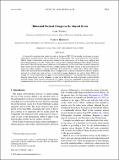| dc.contributor.author | Heimbach, Patrick | |
| dc.contributor.author | Wunsch, Carl Isaac | |
| dc.date.accessioned | 2015-03-03T16:31:38Z | |
| dc.date.available | 2015-03-03T16:31:38Z | |
| dc.date.issued | 2014-06 | |
| dc.date.submitted | 2014-02 | |
| dc.identifier.issn | 0022-3670 | |
| dc.identifier.issn | 1520-0485 | |
| dc.identifier.uri | http://hdl.handle.net/1721.1/95746 | |
| dc.description.abstract | A dynamically consistent state estimate is used for the period 1992–2011 to describe the changes in oceanic temperatures and heat content, with an emphasis on determining the noise background in the abyssal (below 2000 m) depths. Interpretation requires close attention to the long memory of the deep ocean, implying that meteorological forcing of decades to thousands of years ago should still be producing trendlike changes in abyssal heat content. Much of the deep-ocean volume remained unobserved. At the present time, warming is seen in the deep western Atlantic and Southern Oceans, roughly consistent with those regions of the ocean expected to display the earliest responses to surface disturbances. Parts of the deeper ocean, below 3600 m, show cooling. Most of the variation in the abyssal Pacific Ocean is comparatively featureless, consistent with the slow, diffusive approach to a steady state expected there. In the global average, changes in heat content below 2000 m are roughly 10% of those inferred for the upper ocean over the 20-yr period. A useful global observing strategy for detecting future change has to be designed to account for the different time and spatial scales manifested in the observed changes. If the precision estimates of heat content change are independent of systematic errors, determining oceanic heat uptake values equivalent to 0.1 W m[superscript −2] is possibly attainable over future bidecadal periods. | en_US |
| dc.description.sponsorship | United States. National Aeronautics and Space Administration | en_US |
| dc.description.sponsorship | National Oceanographic Partnership Program (U.S.) | en_US |
| dc.language.iso | en_US | |
| dc.publisher | American Meteorological Society | en_US |
| dc.relation.isversionof | http://dx.doi.org/10.1175/jpo-d-13-096.1 | en_US |
| dc.rights | Article is made available in accordance with the publisher's policy and may be subject to US copyright law. Please refer to the publisher's site for terms of use. | en_US |
| dc.source | American Meteorological Society | en_US |
| dc.title | Bidecadal Thermal Changes in the Abyssal Ocean | en_US |
| dc.type | Article | en_US |
| dc.identifier.citation | Wunsch, Carl, and Patrick Heimbach. “Bidecadal Thermal Changes in the Abyssal Ocean.” J. Phys. Oceanogr. 44, no. 8 (August 2014): 2013–2030. © 2014 American Meteorological Society | en_US |
| dc.contributor.department | Massachusetts Institute of Technology. Department of Earth, Atmospheric, and Planetary Sciences | en_US |
| dc.contributor.mitauthor | Wunsch, Carl | en_US |
| dc.contributor.mitauthor | Heimbach, Patrick | en_US |
| dc.relation.journal | Journal of Physical Oceanography | en_US |
| dc.eprint.version | Final published version | en_US |
| dc.type.uri | http://purl.org/eprint/type/JournalArticle | en_US |
| eprint.status | http://purl.org/eprint/status/PeerReviewed | en_US |
| dspace.orderedauthors | Wunsch, Carl; Heimbach, Patrick | en_US |
| dc.identifier.orcid | https://orcid.org/0000-0001-6808-3664 | |
| dc.identifier.orcid | https://orcid.org/0000-0003-3925-6161 | |
| mit.license | PUBLISHER_POLICY | en_US |
| mit.metadata.status | Complete | |
